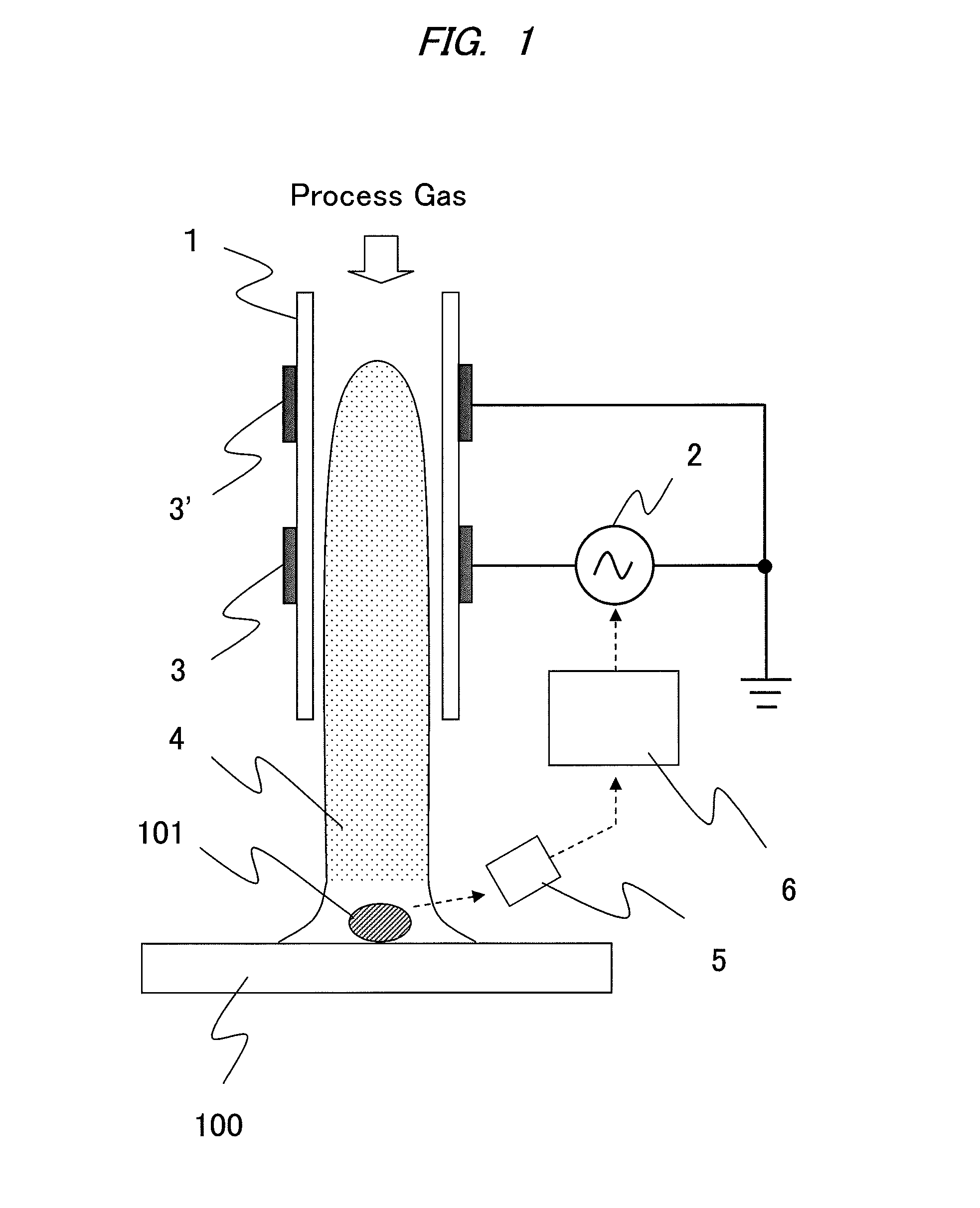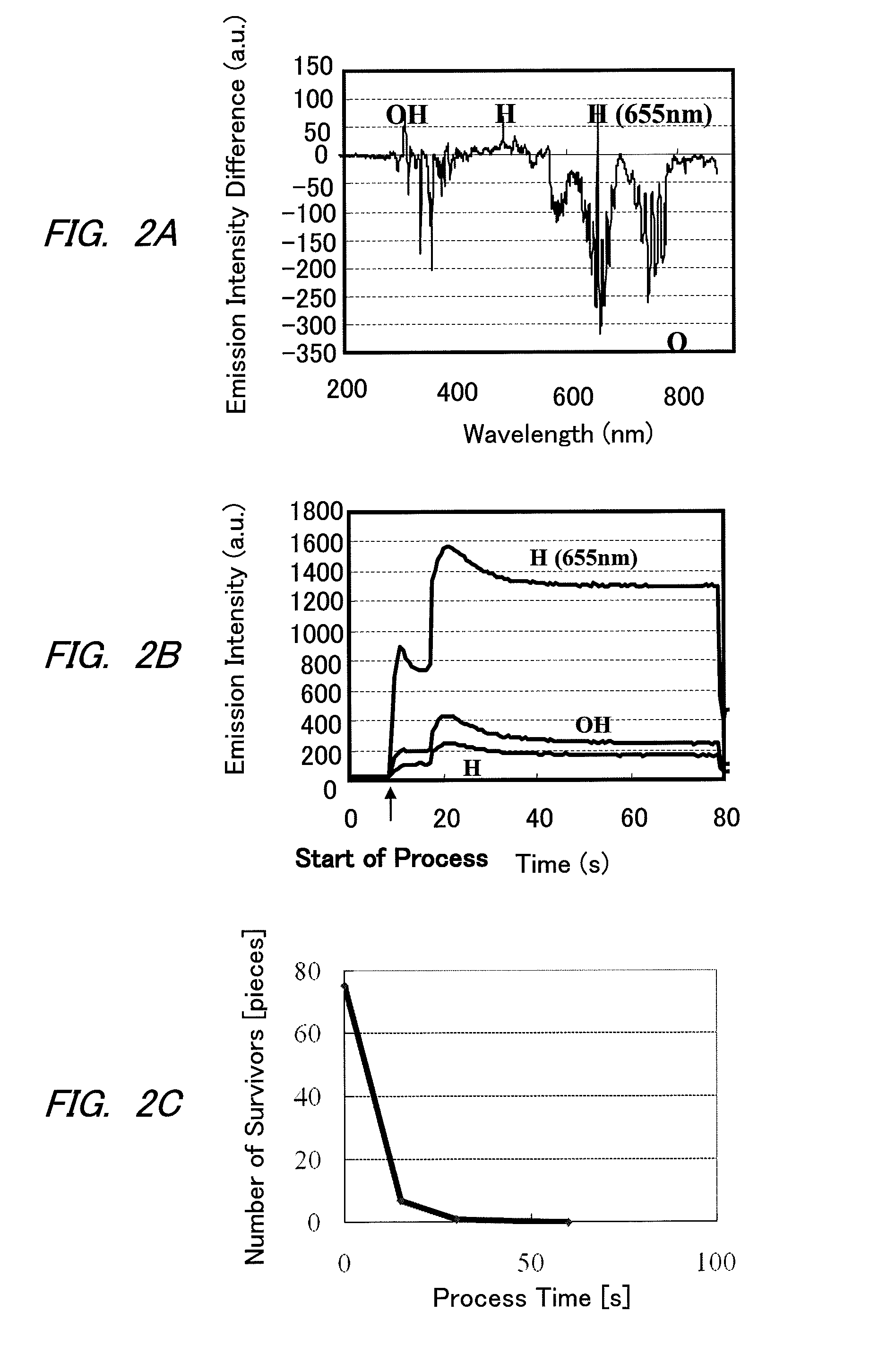Plasma sterilizer, plasma sterilization system, and plasma sterilization method
a sterilizer and plasma technology, applied in the field of sterilization apparatus, can solve the problems of difficult application of the sterilization methods mentioned above in a bcr, inability to use heat sterilization methods which raise the temperature to about 120° c., and process time problems, and achieve the effect of high efficiency sterilization upon sterilization process
- Summary
- Abstract
- Description
- Claims
- Application Information
AI Technical Summary
Benefits of technology
Problems solved by technology
Method used
Image
Examples
first embodiment
[0038]FIG. 1 is a schematic diagram illustrating a configuration of a plasma sterilizer according to the present invention. Under the atmospheric pressure, there is a plasma source to which a process gas is supplied. In the plasma source, a high-frequency electrode 3 to which power is applied from a high-frequency power supply 2 and a ground electrode 3′ are provided and the plasma source generates plasma 4 inside a tube of an insulator 1 to irradiate plasma to a processing target organism 101 that is on a processing target surface 100.
[0039]Incidentally, the irradiation of the plasma as referred to herein is gas generated upon discharge and it is directed to a state in which freely moving charged particles are present and electrically neutral. That is, phenomena not only the discharging portion directly works on bacteria but also radicals generated by the discharge gives a sterilization effect on bacteria are included. Thus, the sterilization process can be performed when a generat...
second embodiment
[0066]A second embodiment of the present invention will be described hereinafter. Even when other plasma generating methods than that of the first embodiment is used, determination of presence and inactiveness of a target processing organism 101 by light emission spectrum of the present invention is possible.
[0067]For example, FIG. 3 is a schematic diagram illustrating another example of the configuration of the plasma sterilization apparatus of the present invention. In the structure, a high-frequency electrode 3 and a ground electrode 3′ are facing each other and at least one of the electrodes is protected by an insulator 1. Plasma 4 is generated at a portion where a space between the facing electrodes is the narrowest and irradiated onto the target processing organic 101 that is on a target processing surface 100 along a flow of a process gas.
[0068]A spectrometer 5 and a control board 6 are installed in the same manner as the first embodiment and an output of a high-frequency pow...
third embodiment
[0072]A third embodiment of the present invention will be described hereinafter.
[0073]FIG. 5 is a schematic diagram illustrating a plasma sterilization apparatus and a configuration of a target processing surface of the present invention. By providing a ground electrode for target processing surface 7 to a topmost surface of a target processing surface 100, an electric field is formed between a high-frequency electrode 4 and the ground electrode for target processing surface 7. In this manner, plasma is accelerated in the electric field and collide with the target processing organism 101 and thus hydrogen desorption of the target processing organism by oxygen radicals is accelerated.
[0074]As a result, hydrogen radicals generated per a unit time are increased and light emission detection of hydrogen is made easier. Also, required time of inactivation can be also shortened.
PUM
 Login to View More
Login to View More Abstract
Description
Claims
Application Information
 Login to View More
Login to View More - R&D
- Intellectual Property
- Life Sciences
- Materials
- Tech Scout
- Unparalleled Data Quality
- Higher Quality Content
- 60% Fewer Hallucinations
Browse by: Latest US Patents, China's latest patents, Technical Efficacy Thesaurus, Application Domain, Technology Topic, Popular Technical Reports.
© 2025 PatSnap. All rights reserved.Legal|Privacy policy|Modern Slavery Act Transparency Statement|Sitemap|About US| Contact US: help@patsnap.com



